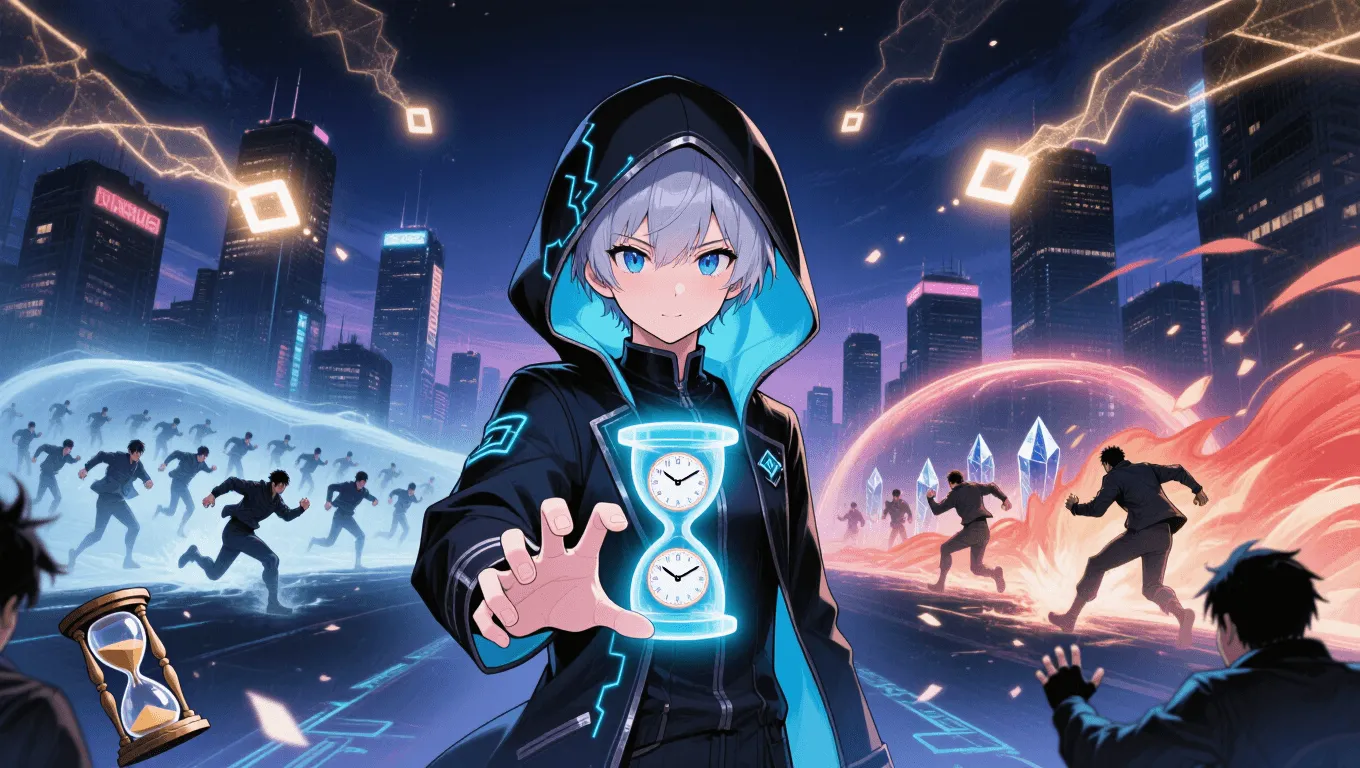Time Manipulation | Chronokinesis

Time Manipulation | Chronokinesis Video Demo 🎬
Table of Contents
- Time Manipulation | Chronokinesis Video Demo 🎬
- What Is Time Manipulation | Chronokinesis
- Core Abilities of Time Manipulation | Chronokinesis
- Application / Tactical Advantages in Combat
- Level: Level 1 🏙️, Level 2 🌇, Level 3 🌃
- Limitations of Using the Time Manipulation | Chronokinesis
- Weakness Against What Other Superpowers
- Synergistic Power Combos
- Known Users
Time Manipulation, also known as chronokinesis, is the superpower to control, alter, and perceive the timestream. In fiction and tabletop RPGs, this ability ranges from subtle time dilation to dramatic feats like stopping time, rewinding moments, and creating time loops. Because it can decide the pace and outcome of any scene, Time Manipulation is often considered a high-tier ability set. This guide breaks down how it works, where it shines, and how to balance it fairly in stories, games, or character builds. For more powers to pair with it, explore the complete catalog in the superpower wiki or try a random pick with the generator.
What Is Time Manipulation | Chronokinesis
Time Manipulation is the capacity to influence temporal flow: speeding it up, slowing it down, halting it locally, or shifting one’s position along the timeline. A chronokinetic user taps chronal energy to cause time dilation, accelerates actions relative to the world, or rewinds states to an earlier configuration. In advanced forms, it can branch timelines, create paradox-safe bubbles, or anchor people so they resist temporal shifts.
In practical terms, the power functions through fields, waves, or zones that modify time’s rate around targets. Characters can apply these zones broadly (an area-of-effect timestop) or precisely (rewinding a single object two seconds). Most settings impose guardrails like temporal entropy, causality resistance, or limited chronal bandwidth to keep the ability interesting and balanced.
Core Abilities of Time Manipulation | Chronokinesis
Localized Time Slow/Acceleration
The user creates a bubble where time runs at a different rate. Inside the bubble, allies act with rapid-fire precision while enemies move in molasses. Outside observers may see blurs or stutters, signaling time shift effects.
Time Stop (Short Burst)
A focused timestop freezes a scene for a heartbeat to several seconds. The user can move, reposition, or disarm foes, but heavy interactions (like dragging a car) often break the stop or burn extra energy. This is the iconic “blink and the battlefield changed” move.
Rewind and Fast-Forward (Micro-Reversion)
The user reverts an object, person, or area to a previous state—undoing a broken lock, healing a recent wound, or resetting a trap. Fast-forwarding can advance processes like plant growth or detonator timers. Most systems limit the window (for example, up to 10 seconds) to avoid rewriting entire histories.
Temporal Perception and Chronal Awareness
Enhanced awareness lets the user read near-future micro-possibilities, anticipate attacks via temporal echoes, and detect timeline distortions. This is similar to predictive combat sense but grounded in time control rather than pure precognition.
Time Loop Setup
A short-loop scenario repeats a span until a condition is met. The user “saves” before an attempt and “loads” upon failure, learning each time. Loops are taxing and can strain sanity or cause echo memories.
Temporal Anchor and Chrono-Lock
A temporal anchor pins a character’s state so outside time shifts cannot alter them—handy against enemy chronomancers. Chrono-locks can also preserve items against aging, decay, or temporal erasure.
Age Manipulation (Restricted)
Some variations permit accelerating or reversing age for living beings, with ethical and balance implications. Many rule sets restrict this to non-living matter or small increments for fairness.
Causality Safeguards
Advanced users build causality buffers—rules that prevent paradoxes or reality fractures. Buffers might enforce conservation (changes demand equal cost) or shunt contradictions into alternate branches.
Application / Tactical Advantages in Combat
Alpha-Tempo Advantage
By accelerating their personal timeframe, a chronokinetic gains more actions per combat round, repositions freely, and executes complex maneuvers before opponents can react.
Defense Through Delay
Slowing incoming projectiles or melee swings turns lethal blows into manageable threats. A split-second rewind can “un-take” damage if the hit occurred within the rewind window.
Control and Disruption
Timestops interrupt spellcasting, reload cycles, or charge-ups. Time loops allow repeated attempts to bypass boss mechanics. Temporal anchors negate enemy rewinds and protect objectives from undoing.
Utility and Team Support
Rewinding broken gear, accelerating medical treatment, or freezing a collapsing structure can save missions. Chronal awareness helps with scouting, trap detection, and predicting ambushes.
Level: Level 1 🏙️, Level 2 🌇, Level 3 🌃
Level 1 🏙️: Street-Tier Chronokinesis
New users manipulate small moments and small spaces.

-
Personal acceleration for brief bursts (1–2 extra actions).
-
Local slow field affecting a single target or small object.
-
Micro-rewind up to 3 seconds on items (jammed gun, tripped laser).
-
Basic chronal awareness: slight predictive sense, noticing time anomalies.
-
Costs: noticeable fatigue, cooldown after each use.
Playstyle: reactive and tactical, excelling at clutch saves and precision moves.
Level 2 🌇: City-Tier Chronokinesis
Intermediate users reshape encounters and short scenes.

-
Area slow/acceleration covering a room or street segment.
-
Short timestop (1–3 seconds subjective) with limited interactions.
-
Rewind/fast-forward up to 10–30 seconds on objects or localized areas.
-
Time loop setup for short spans (e.g., a 5-second retry window).
-
Temporal anchor for self or an ally for a few turns.
-
Costs: rising chronal strain, risk of temporal feedback or nausea.
Playstyle: battlefield controller, can rewrite small mistakes and lock in advantages.
Level 3 🌃: Night-Tier Chronokinesis
Experts bend causality and enforce outcomes—carefully.

-
Multi-target timestops and layered acceleration/slow fields.
-
Selective rewind of complex states (several targets) within strict limits.
-
Stable short time loops with memory retention.
-
Chrono-lock zones that resist other temporal powers.
-
Limited branch management (divert contradictions to safe timelines).
-
Costs: severe entropy buildup, potential paradox backlash if overused.
Playstyle: strategic architect of scenes, but must manage costs to avoid collapse.
Limitations of Using the Time Manipulation | Chronokinesis
-
Chronal Bandwidth: Only so many temporal edits can occur before entropy spikes. Overuse causes headaches, nosebleeds, or blackout—some settings call this time-lag.
-
Window of Influence: Rewinds and fast-forwards are usually capped by duration or scope. Large-scale historical changes are gated or outright forbidden.
-
Interaction Limits: During timestop, heavy manipulation of mass, complex electronics, or energy fields may fail or break the stop. Some narratives restrict offensive actions to prevent “frozen assassination.”
-
Causality Resistance: Important events or “fixed points” resist change. Trying to alter them can cause recoil damage or timeline fractures.
-
Observation Paradox: If many observers remember a prior state, the universe may “hard-save” it. Changing such states needs higher cost or consent mechanics.
-
Anchors and Dead Zones: Tech or magic that establishes temporal anchors can nullify or dampen the user’s effects. Areas with chronal storms behave unpredictably.
-
Moral and Narrative Constraints: Age manipulation and broad historical edits introduce ethical issues that smart GMs restrict for table harmony.
Weakness Against What Other Superpowers
-
Temporal Immunity / Chronal Anchors: Opponents with innate anchors ignore slow fields, rewinds, or timestops inside their buffer.
-
Reality Stabilization / Probability Control: Probability controllers can force outcomes that resist time edits, making rewinds converge on the same result.
-
Nullification Fields: Power dampening zones collapse chronal constructs and block field projection.
-
Quantum Phasing / Intangibility: Phased targets may not be “grippable” by local time fields, slipping through slow bubbles.
-
High-Speed Perception: Characters with super-speed perception can partially function during timestop or accelerated phases, reducing the advantage.
-
Information Warfare: Memory scramblers and illusion casting can corrupt loop-learned data, making each retry less reliable.
Synergistic Power Combos
-
Time Manipulation + Telekinesis: Stop time, reposition enemies or debris safely, then resume for instant battlefield rearrangement.
-
Time Manipulation + Healing/Regeneration: Rewind wounds to pre-injury states or fast-forward natural recovery, turning triage into seconds.
-
Time Manipulation + Precognition: Combine near-future sight with local rewind to test branches rapidly, finding the best timeline with minimal risk.
-
Time Manipulation + Energy Shield/Force Fields: Stabilize a time bubble with a barrier so external disruptions can’t collapse the effect.
-
Time Manipulation + Illusion Casting: Loop tests to calibrate perfect misdirections and exploit enemy reaction patterns.
-
Time Manipulation + Dimensional Manipulation: Route paradox overflow into pocket dimensions and maintain causality buffers cleanly.
Known Users
-
Barry Allen (The Flash) — Often depicted interacting with the Speed Force to create time travel arcs and time remnants. Read more.
-
Kang the Conqueror — A strategist who weaponizes branching timelines and temporal tech for domination. Read more.
-
Doctor Strange — Frequently shown using chronal artifacts to view futures or loop events for leverage. Read more.
For more ideas and cross-ability builds, browse the expanding superpower wiki or roll something unexpected with the random superpower generator.
